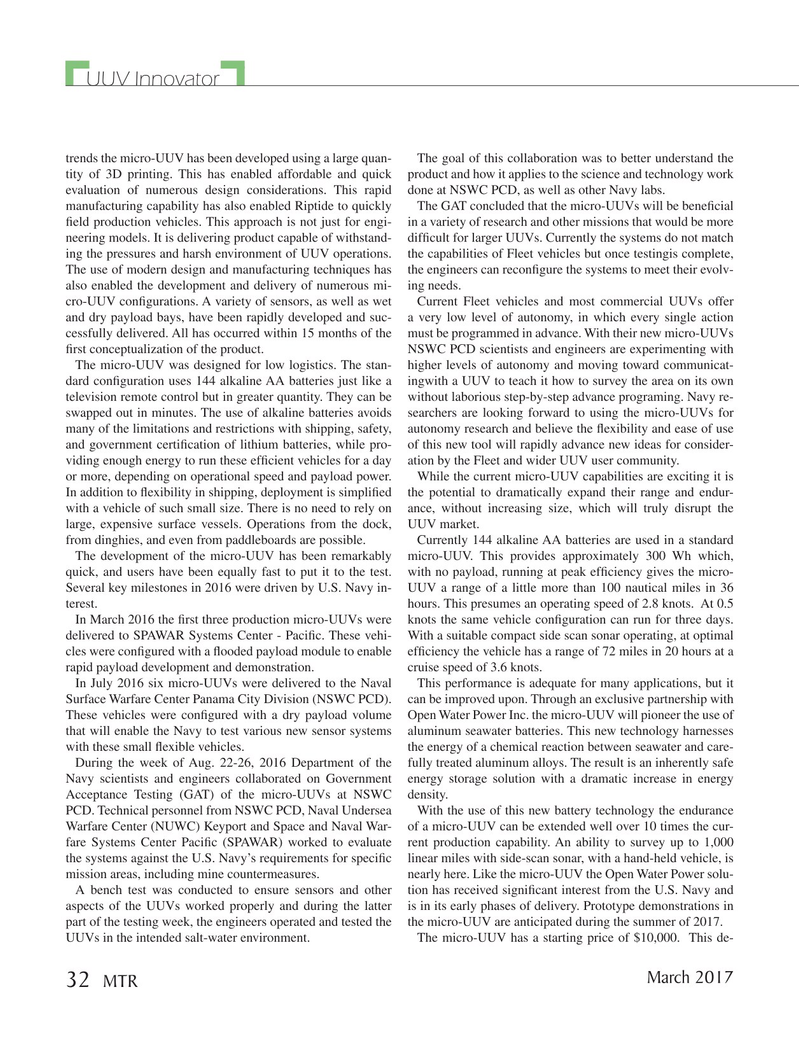
Page 32: of Marine Technology Magazine (March 2017)
Oceanographic Instrumentation: Measurement, Process & Analysis
Read this page in Pdf, Flash or Html5 edition of March 2017 Marine Technology Magazine
UUV Innovator trends the micro-UUV has been developed using a large quan- The goal of this collaboration was to better understand the tity of 3D printing. This has enabled affordable and quick product and how it applies to the science and technology work evaluation of numerous design considerations. This rapid done at NSWC PCD, as well as other Navy labs.
manufacturing capability has also enabled Riptide to quickly The GAT concluded that the micro-UUVs will be bene? cial ? eld production vehicles. This approach is not just for engi- in a variety of research and other missions that would be more neering models. It is delivering product capable of withstand- dif? cult for larger UUVs. Currently the systems do not match ing the pressures and harsh environment of UUV operations. the capabilities of Fleet vehicles but once testingis complete,
The use of modern design and manufacturing techniques has the engineers can recon? gure the systems to meet their evolv- also enabled the development and delivery of numerous mi- ing needs.
cro-UUV con? gurations. A variety of sensors, as well as wet Current Fleet vehicles and most commercial UUVs offer and dry payload bays, have been rapidly developed and suc- a very low level of autonomy, in which every single action cessfully delivered. All has occurred within 15 months of the must be programmed in advance. With their new micro-UUVs ? rst conceptualization of the product. NSWC PCD scientists and engineers are experimenting with
The micro-UUV was designed for low logistics. The stan- higher levels of autonomy and moving toward communicat- dard con? guration uses 144 alkaline AA batteries just like a ingwith a UUV to teach it how to survey the area on its own television remote control but in greater quantity. They can be without laborious step-by-step advance programing. Navy re- swapped out in minutes. The use of alkaline batteries avoids searchers are looking forward to using the micro-UUVs for many of the limitations and restrictions with shipping, safety, autonomy research and believe the ? exibility and ease of use and government certi? cation of lithium batteries, while pro- of this new tool will rapidly advance new ideas for consider- viding enough energy to run these ef? cient vehicles for a day ation by the Fleet and wider UUV user community.
or more, depending on operational speed and payload power. While the current micro-UUV capabilities are exciting it is
In addition to ? exibility in shipping, deployment is simpli? ed the potential to dramatically expand their range and endur- with a vehicle of such small size. There is no need to rely on ance, without increasing size, which will truly disrupt the large, expensive surface vessels. Operations from the dock, UUV market. from dinghies, and even from paddleboards are possible. Currently 144 alkaline AA batteries are used in a standard
The development of the micro-UUV has been remarkably micro-UUV. This provides approximately 300 Wh which, quick, and users have been equally fast to put it to the test. with no payload, running at peak ef? ciency gives the micro-
Several key milestones in 2016 were driven by U.S. Navy in- UUV a range of a little more than 100 nautical miles in 36 terest. hours. This presumes an operating speed of 2.8 knots. At 0.5
In March 2016 the ? rst three production micro-UUVs were knots the same vehicle con? guration can run for three days. delivered to SPAWAR Systems Center - Paci? c. These vehi- With a suitable compact side scan sonar operating, at optimal cles were con? gured with a ? ooded payload module to enable ef? ciency the vehicle has a range of 72 miles in 20 hours at a rapid payload development and demonstration. cruise speed of 3.6 knots.
In July 2016 six micro-UUVs were delivered to the Naval This performance is adequate for many applications, but it
Surface Warfare Center Panama City Division (NSWC PCD). can be improved upon. Through an exclusive partnership with
These vehicles were con? gured with a dry payload volume Open Water Power Inc. the micro-UUV will pioneer the use of that will enable the Navy to test various new sensor systems aluminum seawater batteries. This new technology harnesses with these small ? exible vehicles. the energy of a chemical reaction between seawater and care-
During the week of Aug. 22-26, 2016 Department of the fully treated aluminum alloys. The result is an inherently safe
Navy scientists and engineers collaborated on Government energy storage solution with a dramatic increase in energy
Acceptance Testing (GAT) of the micro-UUVs at NSWC density.
PCD. Technical personnel from NSWC PCD, Naval Undersea With the use of this new battery technology the endurance
Warfare Center (NUWC) Keyport and Space and Naval War- of a micro-UUV can be extended well over 10 times the cur- fare Systems Center Paci? c (SPAWAR) worked to evaluate rent production capability. An ability to survey up to 1,000 the systems against the U.S. Navy’s requirements for speci? c linear miles with side-scan sonar, with a hand-held vehicle, is mission areas, including mine countermeasures. nearly here. Like the micro-UUV the Open Water Power solu-
A bench test was conducted to ensure sensors and other tion has received signi? cant interest from the U.S. Navy and aspects of the UUVs worked properly and during the latter is in its early phases of delivery. Prototype demonstrations in part of the testing week, the engineers operated and tested the the micro-UUV are anticipated during the summer of 2017.
UUVs in the intended salt-water environment. The micro-UUV has a starting price of $10,000. This de-
March 2017 32 MTR
MTR #2 (18-33).indd 32 MTR #2 (18-33).indd 32 2/28/2017 5:38:00 PM2/28/2017 5:38:00 PM

 31
31

 33
33
